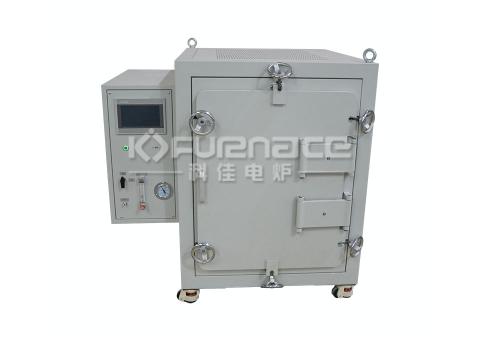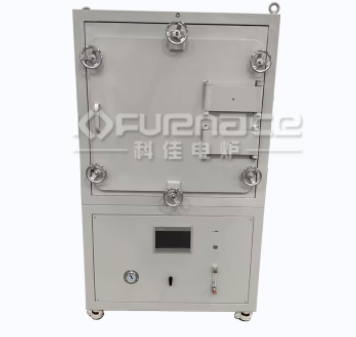The selection of high-temperature atmosphere furnace is a process that comprehensively considers multiple factors. Let’s take a detailed look below!

A commonly used experimental small high temperature box atmosphere furnace (click on the image to view product details)
1. Clear usage requirements
Firstly, it is necessary to clarify the main purpose of the high-temperature atmosphere furnace, such as:
Metal heat treatment: annealing, normalizing, tempering, etc.
Ceramic sintering: special ceramics, electronic ceramics, structural ceramics, etc.
Material synthesis: powder metallurgy, chemical vapor deposition (CVD), etc.
The usage requirements will determine key parameters such as the temperature range, atmosphere control type, and furnace size of the required furnace.
2. Temperature range and accuracy
Temperature range: Select a furnace that can achieve the required high and low temperatures according to experimental or process requirements. For example, the temperature range of some high-temperature atmosphere furnaces can reach 1700 ℃ or higher.
Temperature accuracy: For experiments that require precise temperature control, an electric furnace with a high-precision temperature control system should be selected. The temperature display accuracy can reach 1 ℃, and the temperature field stability is ± 5 ℃.
3. Furnace size and volume
Furnace size: Choose the appropriate furnace size based on the size of the sample or workpiece to be processed. To ensure that the furnace can fully accommodate and evenly heat the sample, while leaving enough space to ensure the uniformity of the atmosphere.
Furnace volume: Considering the quantity and size of experimental samples, select an appropriate furnace volume to improve work efficiency.
4. Atmosphere control
Atmosphere type: Clearly define the required atmosphere type for the experiment (such as nitrogen, argon, hydrogen, oxygen, etc.), and select an electric furnace with corresponding atmosphere control function. The atmosphere control system should be able to accurately control parameters such as gas flow rate and pressure.
Sealing: Good sealing of the furnace body helps maintain stable atmosphere, prevent gas leakage from affecting experimental results or causing safety hazards.
5. Heating element and method
Heating element: Understand the characteristics of different heating elements (such as resistance wire, silicon carbon rod, silicon molybdenum rod, metal wire, etc.), and choose the appropriate heating element based on usage requirements and temperature range. For example, resistance wires are suitable for lower temperatures, while silicon carbon rods and silicon molybdenum rods are suitable for higher temperatures.
Heating method: Consider the energy efficiency and uniformity of the heating method to ensure that the sample is uniformly heated during the heating process.
6. Thermal insulation performance
Insulation material: Choosing a furnace with good insulation performance can reduce heat loss and improve energy efficiency. The insulation material should have the characteristics of high temperature resistance, corrosion resistance, and low thermal conductivity.
Double layer furnace shell structure: Some high-temperature atmosphere furnaces adopt a double layer furnace shell structure, with a fan installed in the middle to quickly raise and lower the temperature. At the same time, the surface temperature of the furnace shell is relatively low, which improves safety.
7. Security performance
Safety protection measures: Ensure that the furnace has safety measures such as over temperature protection, leakage protection, and atmosphere leakage alarm to prevent accidents from occurring.
Convenience of operation: The operation interface should be simple and easy to understand, making it convenient for experimental personnel to use. At the same time, it should have an emergency stop function to quickly cut off the power in case of an emergency.
8. Brand and after-sales service
Brand selection: Choose products from reputable brands, which usually have more reliable quality and stable performance.
After sales service: Suppliers should have good after-sales service and technical support capabilities, so that they can get timely solutions in case of equipment problems. This includes equipment installation, debugging, training, as well as later maintenance and upkeep.
9. Budget and cost-effectiveness
Budget considerations: Choose suitable products based on one’s own economic strength and avoid blindly pursuing high-end configurations.
Cost effectiveness evaluation: Within the budget range, taking into account factors such as equipment performance, quality, and after-sales service, choose products with higher cost-effectiveness.
10. Other precautions
Heating and cooling rate: Rapid heating and cooling rates can increase the thermal stress inside the furnace body and tubes, leading to material fatigue and damage. Therefore, when selecting equipment, attention should be paid to whether its temperature rise and fall rate meets the experimental requirements.
Regular maintenance: High temperature atmosphere furnaces require regular maintenance during use, including cleaning the furnace, inspecting heating elements, replacing seals, etc., to extend the service life of the equipment.

A commonly used atmosphere furnace (click on the image to view product details)
In summary, you can have a more comprehensive understanding of the key points for selecting high-temperature atmosphere furnaces, so as to choose equipment that is more suitable for your needs.Click to learn more Atmosphere Furnaces! Or click on online customer service to learn more about product information!